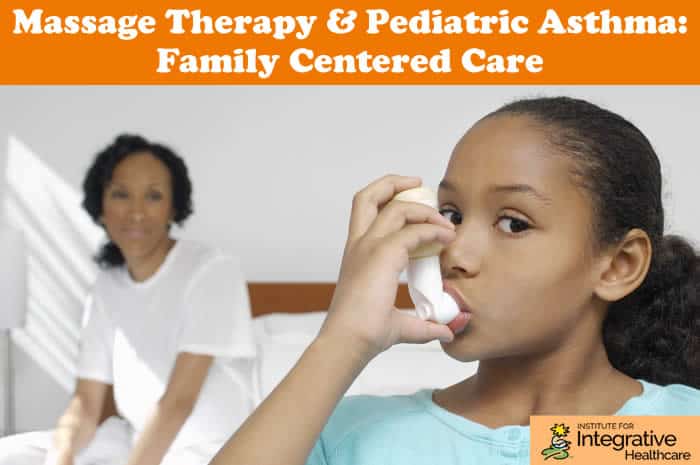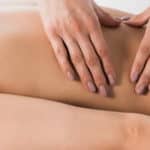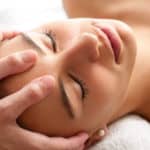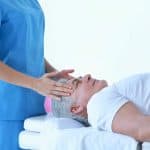

What Is Childhood Asthma?
Asthma is the most common chronic childhood illness. If you are living with asthma, or know someone who does, you understand how complex and challenging it can be to find successful treatment for this condition. A child’s experience with asthma is greatly affected by their home environment and overall sense of health and well-being. The psychological health of the child’s parents or caregivers, and the social-emotional interaction between the parent and child, also play a role in the child’s health. When a child is dealing with a chronic illness, the whole family needs support. Pediatric massage is a positive approach to childhood asthma that benefits both the child and family.
Pediatric Asthma and the Family
Pediatric asthma is a complex inflammatory disease of the respiratory system. Some of the symptoms include:
- chest tightness
- shortness of breath
- coughing
- increased secretion of mucous in the bronchioles
- wheezing
Asthma is most commonly characterized by bronchoconstriction which blocks the pathway for air to enter the lungs. When a child has an asthma attack or acute episode, their breathing patterns are unpredictable. A decrease in oxygen in the body causes alarm and panic, and stress hormones run through the child’s body. Asthma interrupts the child’s normal, daily activities and causes the family members to go into high alert.
The parent’s experience of the disease should not be underestimated. When a child has asthma, their mothers often experience a wide range of emotions such as stress, worry, fear, and guilt. Often, the reciprocal effect occurs too. Children are astute, and can sense the emotions of their caregivers. If mom or dad is anxious, it can often lead to the child feeling more that way too. Anxiety may trigger asthmatic symptoms, be a side effect of the asthmatic condition, or even exacerbate an already existing altered breathing pattern. The emotional stress surrounding childhood asthma is a key component to consider in the treatment.
Massage Therapy for Asthma
There is no cure for asthma. However, there are a variety of interventions that are available for families to keep asthma under control. With holistic supports, families with children with asthma can feel healthy and well. Of primary concern is ensuring the child has the right medical treatment and correct medication for acute symptoms. Once the immediate needs are met, other integrative health modalities may be considered to support the whole family. Research shows us that massage therapy is a modality that may be utilized to help manage the ongoing, milder symptoms and discomforts of asthma. Both parents and children benefit from using simple, effective massage techniques at home.
Pediatric Massage Benefits for the Child
Children with asthma often experience pain throughout their body. Due to ongoing breathing difficulties and related stress, children most commonly have discomfort in their:
- cervical muscles
- thoracic spine
- chest
- ribcage
- and abdominal region.
The two primary breathing muscles are the diaphragm, which sits like a dome at the base of the ribcage, and the intercostal muscles, between the ribs. When breathing is difficult, labored, or altered in any way, accessory breathing muscles need to do extra work to help the child breathe more efficiently. The accessory muscles involved in inhalation and exhalation are:
- scalenes
- pec minor
- abdominals
- serratus anterior
- sternocleidomastoid
- pec major
- subclavius
- quadratus lumborum
- and serratus posterior.
After years of difficult breathing, a child may have extreme tension in muscles of the ribcage and spine. Soothing effleurage massage can help to ease the pain in these overworked muscles. If we can normalize the movement of the respiratory muscles, the modified breathing becomes more easeful and soothes tension for the child. Over time, the muscles will heal and work more efficiently, decreasing the symptoms of asthma.
Just like adults, children experience stress and worry. Pediatric massage can help lower stress levels for children. When children are relaxed, their immune systems are stronger and less vulnerable to environmental allergens. Asthma can cause a type of “panic driven isolation” that leads to more need for medication for asthma attacks, and potentially anti-anxiety medication (Sinclair, 163). Regular massage can prevent emotional stress that may trigger an asthma attack or make it worse. When we reduce the stress hormone such as cortisol through massage, we provide the immune system the opportunity to strengthen and help the child feel healthy and well. According to research done at the Touch Research Institute, children with asthma show improved pulmonary function and decreased anxiety following regular pediatric massage.
Pediatric Massage Benefits for the Family
Parents play a vital role in the ongoing care of their children. When a child has a serious, long term condition such as asthma, parents are searching for answers and want to be able to offer care that will help their children feel better. Pediatric massage at home is an effective intervention for children with asthma.
A massage therapist, knowledgeable in pediatric massage, can teach parents how to do touch therapy for asthma at home. A basic massage sequence, focused on relaxing the breathing muscles is best. Once parents are taught the simple techniques, they can do them at home. The massage can be performed in a short period of time, (i.e. 20 minutes per day before bedtime).
There are many benefits to this important type of care. When regular massage is shared with a child, there is less need for over the counter medication. Therefore, it helps to reduce medical costs for the parents, and lessening the overall financial burden.
Pediatric massage given at home also has the benefit of reducing stress levels for the parents. The parents feel more empowered, knowing they have tools and strategies that are effective to support their children. Parent and child both have an opportunity during the session to relax and connect with one another, ultimately lowering levels of stress and anxiety for both of them.
Also, parents can give massage without worry of side effects. Once they know a few massage strategies, they can be adapted for most areas of the body. Over time, pediatric massage treatment at home supports the efficacy of traditional medical interventions and eventually improves asthma symptoms for children.
Stress and Asthma
One more note about stress and asthma. Research also finds that the more we understand about the connection between stress and asthma, the better off we are. The more we understand about how to rest and relax, and the benefits of massage, the more effective massage treatment can be for our well-being. Parents may take time to discuss with their children this connection while giving massage. For instance, parents can say, “If you relax your shoulders, back, and belly like this, it will help you to feel better.” These conversations, along with massage, help children develop body awareness, learn how to relax, and let go of stress.
Overall, families experience an improvement in the quality of their life together when using massage at home. Pediatric massage has wide reaching benefits for childhood asthma and beyond.















